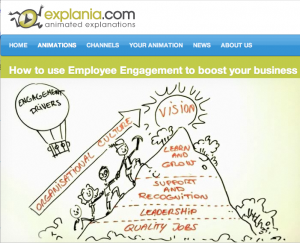Topical Categories
Archives
Breaking Creative & Innovative Thinking Out of Their Boxes Through Creative Problem-Solving
Happy Leap Day, all! May we all make great use of this "extra day" we get every four years on the 29th of February! EnJoy!
The new combined Kowabunga! & Riding the Wave Training & Development website is still in the final stages of getting its bugs worked out, but will be returning soon with new musings and resources. In the meantime, inspired by a recent conversation and having missed being in touch, I wanted to say "Aloha!" and share a few thoughts from my Sabbatical perch (Oh, that it were from the beach…).
Creative Thinking as Solution Finding:
In August 2011, I wrote a post on the different forms of innovation, “What Does Innovation Mean? Many Things.” http://ridingthewave.net/2011/08/.
In brief, creative, divergent, or “out of the box” thinking, as it is so often called, has been relegated in the minds of many as "what marketing/ advertising, or maybe some R&D folks do," versus what it actually is, which is:
- The part
 ner of critical thinking.
ner of critical thinking. - The gears for creative problem-solving.
- The foundation of continuous improvement.
- It also is a key component forthe scenario planning that all organizations should be practicing as precursors to their strategic planning processes.
- And yes, of course, creative thinking also results in more obvious innovations in product, service, and market development.
- Creative thinking is also inextricably linked with cultivating an engaged workforce. In a September 2011 post, “A Creative Look at Employee Engagement by Explania,” http://ridingthewave.net/2011/09/ *
This last point is one that remains especially difficult for many in leadership and management roles to see. It is highly improbable that one will find employees willing to give 110% unless they feel they have a voice and input into the creative problem solving, solutions, and continuous improvement processes.
Why would this be? Simply put, when management doesn’t demonstrate genuine interest in the input and ideas of employees by creating mechanisms to capture, vet, and implement the viable ones, staff:
a) do not feel respected, and
 b) feel frustrated when they see ways that processes and services could be improved and feel unable to make a difference.
b) feel frustrated when they see ways that processes and services could be improved and feel unable to make a difference.
Having no ownership in the process, they do not feel inspired to proactively go above and beyond in their duties and may simply be biding their time until they can work elsewhere. Most of us have either witnessed the dynamics of an apathetic workforce or know this from personal experience having worked in companies where we were told, either directly, or indirectly, that we were “not being paid to think beyond our pay grades.”
And everyone loses out, from customers to shareholders, from benefiting from their frontline problem-solving and continuous process improvement ideas, even before they make their exits from their respective organizations.
So, the next time someone says, “We don’t have time for creative and innovative thinking" — try to help him or her to think beyond the box s/he may have placed around those forms of cognition. Insert terms like: “creative problem solving,” “continuous process improvement,” “comprehensive, lasting solutions,” and “engaged workforce,”… — And then ask them whether there is time for that. ???
I look forward to further exploration with you on the links between creative thinking, innovation, best management practices, and organizational success when Kowabunga! returns soon on a regular basis. And in the meantime, "Aloha!"
*Check out the great short educational video on that post: http://www.explania.com/en/animations/detail/how-to-use-employee-engagement-to-boost-your-business.
You can also catch the delightful one-minute video depicted in these photos on "Thinking Outside the Box" at http://www.youtube.com/watch?v=mJ_7gUP42Bk&feature=related.
Other short, brilliant videos on creative and innovative thinking can be viewed on Kowabunga's post from February 24, 2011: http://ridingthewave.net/2011/02/.


Dear Readers,
I promised that our next post was to be on ideas on how to foster the creative collaboration that is foundational to innovation in organizations. I also had some other posts lined up for some logical progression.
However, my time will be very limited for the next several weeks because a U.S. government training project for our returning military personnel is calling upon my creative skills. Imagine that! 😉 — Did I mention that I design and deliver training programs?
In the meantime, I will share a couple of articles that I find of interest that tie directly into what we're exploring together in this forum, which, in simple mathematical formulation can be summarized as:
Curiosity + Creativity
x Good Management (Respect + Support)
= GENIUS!
(Yes, I actually made that up on the spot, and math isn't even my strong suit. 😉 )
Look for themes below that tie back to previous posts. Again, it can all tie back to our earlier posts on the 2010 IBM CEO report on best practices for organizations that want to thrive and key points we reviewed from How to Think Like Leonardo da Vinci:
- Einstein never squelched the innate curiosity that we all were born with. He just loved to learn and explore; that was his primary drive.
- He didn't grow up in a family who's main preoccupation in life was looking good and fitting in. Modus operandi such as that does not generally foster original thinking. Integrity does.
- He wasn't afraid to experiment and (gasp!) fail as a means of learning what didn't work, so he could ultimately uncover what did.
- He used "whole brain thinking" with the music; let his mind wander with daydreaming and unrelated things while his subconscious continued to problem solve; he was suspicious of the convergent "single answer" thinking encouraged in many of our schools and organizations; and, I like this one, he believed we could learn about the spiritual realities (or, for those who prefer, God) by paying attention to the world around us. — A very worthwhile pursuit.
Namaste! EnJOY!
| How Einstein Got So Smart – 10 Learning Hacks |
 How would you feel if many people thought you were the smartest person in history? How might your life be different if you actually were that intelligent? Although we often think of Albert Einstein as one of the smartest people ever, we don’t investigate what it was that made him so. People who speak highly of him often attribute his genius to some mysterious gift. They don’t believe his smarts came from a certain attitude about learning. I believe you can recreate some of his habits to get smarter and find more rewarding work. How would you feel if many people thought you were the smartest person in history? How might your life be different if you actually were that intelligent? Although we often think of Albert Einstein as one of the smartest people ever, we don’t investigate what it was that made him so. People who speak highly of him often attribute his genius to some mysterious gift. They don’t believe his smarts came from a certain attitude about learning. I believe you can recreate some of his habits to get smarter and find more rewarding work.
Einstein…the Failure?Before you get the list of Einstein’s learning habits, consider some interesting facts about his early life. These things set the stage for appreciating his educational philosophy a little more.
These things represent just a taste of the irony about his early life. Looking back – in light of his eventually recognized genius – these facts even seem humorous. 10 Things Einstein Did to Get So SmartFrom what I can find, no one has compiled details about how Einstein actually studied. I doubt that his true genius was even observable to the eye anyhow. The real accomplishments went on inside his mind. I suspect his brain looked no different than ours; and genetically, nothing seemed remarkable. So, to benefit from his example, we need to look as much at his character and philosophy about learning.
|
- Adapting to Change & overcoming Fear
- Ambiguity and embracing the Unknown
- Apple and/or Steve Jobs
- Business Reports: 2010 IBM CEO & 2010 BCG
- Changing Cultures to become Innovative
- Collaboration vs. Silos
- Continuous Improvement or Process Improvement
- Creative Arts & Innovation
- Creative Genius among Staff
- Creative Problem Solving
- Creative Thinking Practices & Exercises
- Creativity/Innovation
- Critical Thinking
- Curiosity & Asking Questions
- Divergent vs. Convergent thinking
- Employee Engagement
- Fun and innovation
- Hierarchy vs. Innovation
- How to Think Like Leonardo da Vinci
- Innovation & the Economy
- Innovation in Government
- Innovation in History
- Integrity; Following own drummer
- Langdon Morris
- Leadership & Management Best Practices
- Learning from Mistakes
- Lifelong Learning and innovation
- Mentoring and innovation
- Model Innovative Organizations
- Podcasts on innovation
- Processes and Structures for Innovation
- Redefining Innovation
- Scenario Planning
- Six Sigma and LEAN vs. innovation
- Social Change and Innovation
- Spirituality in Workplace and innovation
- Trust and Respect in Engagement and Innovation
- Types of Innovation
- Weirdness and Creativity
- What-iffing
- Whole Brain Thinking
- YouTube Videos


